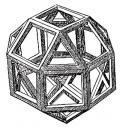Girondins
From The Art and Popular Culture Encyclopedia
.jpg)
|
Related e |
|
Featured: |
The Girondists were a political faction in France within the Legislative Assembly and the National Convention during the French Revolution. They campaigned for the end of the monarchy but then resisted the spiraling momentum of the Revolution. They came into conflict with The Mountain (Montagnards, a more radical faction within the Jacobin Club). This conflict eventually led to the fall of the Girondists and their mass execution, the beginning of the Reign of Terror. The Girondists were a group of loosely-affiliated individuals rather than an organised political party, and the name was at first informally applied because the most prominent exponents of their point of view were deputies to the States-general from the department of Gironde in southwest France.
The famous painting Death of Marat depicts the revenge killing of radical journalist (and denouncer of the Girondists) Jean-Paul Marat by Girondist sympathizer, Charlotte Corday. Some prominent Girondists were Jacques Pierre Brissot, Jean Marie Roland and his wife. They had an ally in Thomas Paine. Brissot and Madame Roland were executed with the guillotine and Jean Roland (who was in hiding) committed suicide when he learned what had transpired. Paine was arrested and imprisoned but narrowly escaped execution.
See also

